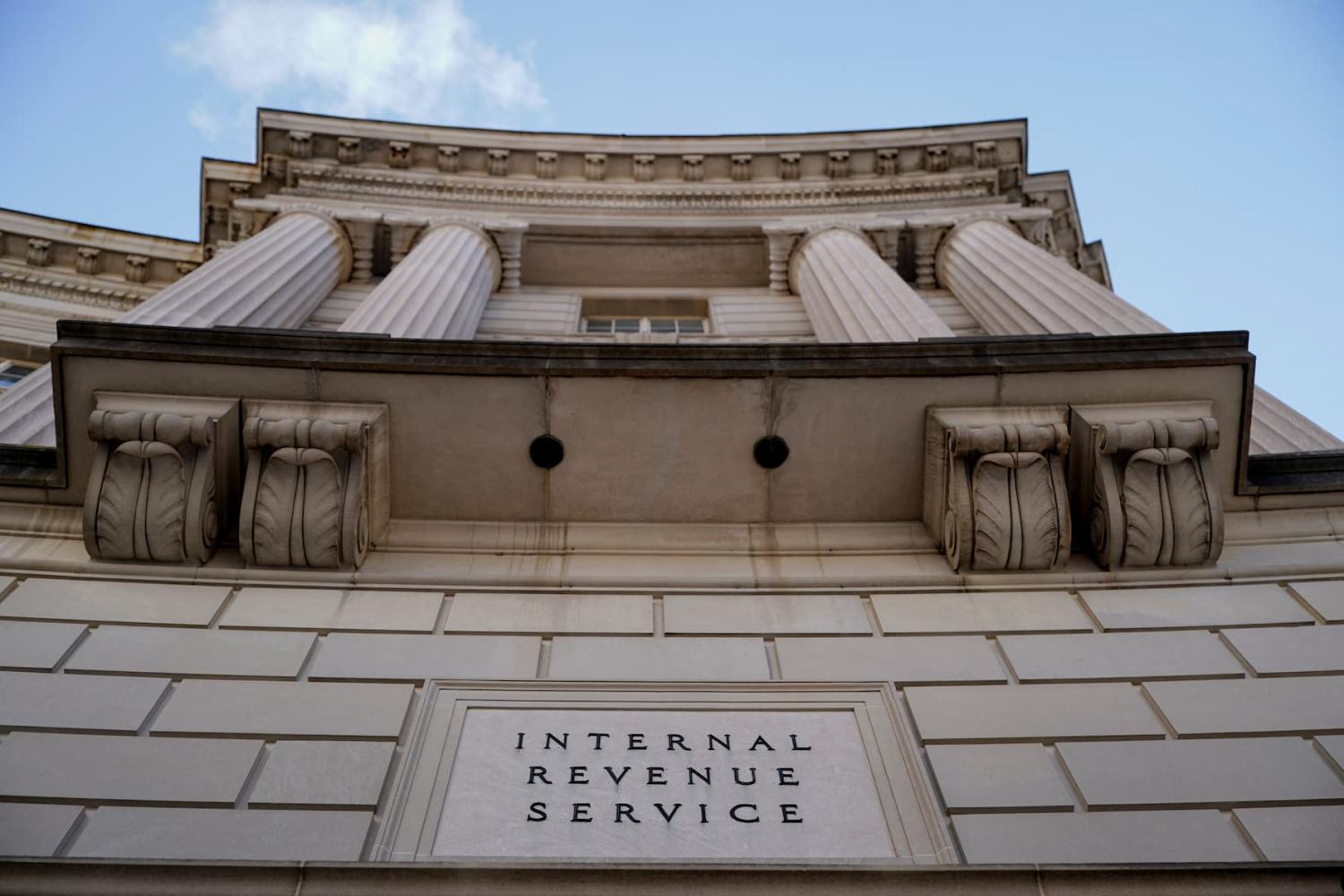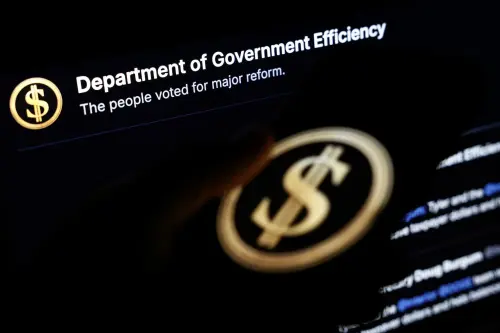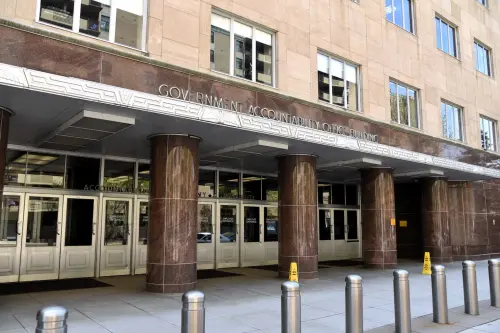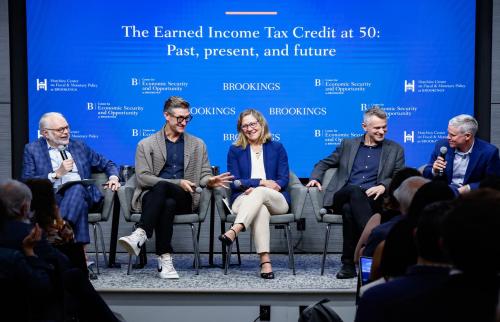“I will commit that, for this tax season, that Direct File will be operative,” Treasury Secretary Scott Bessent said at his confirmation hearing in January—an apparent reprieve for one of the Biden administration’s most unalloyed successes: the launch of free, public federal tax preparation.
Less than three weeks later, as his secretive young coterie seized the levers of government, Elon Musk replied to a tweet calling “18F,” the digital team in the General Services Administration that helped develop Direct File, a “far left government wide computer office.” Musk asserted that the group had been “deleted,” sparking widespread concern that the Direct File program was among the many casualties of the new administration’s lawlessness.
The concerns were understandable but ill-founded. Though the IRS has been targeted for immense and haphazard workforce reductions, Direct File is still fully functional. This year, about 30 million Americans in 25 states can file their taxes using this free public software.
As we confront the fundamental threats that the Trump-Musk administration is posing to the Constitution and the rule of law, there is much to learn from the travails of our tax system. The Internal Revenue Service has long been on the front line of conservative attacks on the most basic functions of government. The history of our federal revenue agency since the Reagan era—its long decline and its fledgling renaissance—provides a warning about what happens when vital government agencies are eroded, and a model for how those pillars of governance can be rebuilt.
First, a recap on Direct File.
In 2024, the IRS launched an ambitious test of a new government website that would let Americans file their taxes for free.1 On everyone’s mind was the utter debacle of “healthcare.gov,” the Obama-era initiative that was intended to help Americans navigate the health insurance market. Beset by bad contracting, shifting goals, and fragmented responsibilities, the fundamentally flawed site was launched wholesale to the general public and crashed within two hours.
Direct File would be different. “We’re starting small to get it right,” as the IRS put it. The federal site was built in-house at the IRS. (The 18F digital team at the General Services Administration was only involved during development, so the purported “deletion” of that team would have no effect on the running of the program.)
Direct File was rolled out slowly so that issues could be detected and resolved. The software was at first limited to the simplest tax filings, with additional functionalities to be added over time. States could opt in to participation (often with assistance from the nonprofit Code for America) so that their participants could do both their state and federal taxes. In the end, 140,803 tax filers used the Direct File pilot.
The result was, by any reasonable standard, a triumph. Direct File was deemed a success by the sticklers at both the Treasury Inspector General for Tax Administration and the Government Accountability Office, who audited the program and made recommendations throughout the pilot process. Multiple surveys, conducted by the government and by outside organizations, found very high levels of satisfaction among users. Ninety percent of survey respondents rated their Direct File experience as “excellent” or “above average,” and 86% said it increased their trust in the IRS. Three quarters preferred Direct File over other tax filing methods, and nine in 10 indicated that they would likely recommend the program to others. Participants were similarly positive about the integration of Direct File with state tax filing; a survey of participants in Arizona and New York showed that nine-tenths of participants filed their state taxes within 15 minutes of importing their data from Direct File.
In May 2024, the IRS announced that Direct File would be a permanent public option. Perhaps the most ambitious expansion is data importation so tax filers don’t waste time typing in information that the agency already has on hand. (Economists estimate that the IRS could completely pre-populate tax forms for nearly half of all tax filers; these taxpayers could simply read and confirm the data and hit “submit.”)
With Direct File, the federal government is finally addressing a longstanding problem: Americans spending their time and money—on average, an estimated 13 hours and $290 per individual annual tax return—on paperwork the government could do for them. As early as 1943, Congress considered policies to free most people from having to file income tax returns. President Ronald Reagan proposed return-free tax filing as part of his 1985 tax reform. With the rise of digital record-keeping and online tax filing, free public tax preparation became increasingly feasible. Today, dozens of countries have a public system that imports data onto their taxpayers’ returns, freeing their citizens from an annual expensive paperwork extravaganza that mostly tells the government what it already knows.
Particularly for a one-time pilot program, Direct File has a remarkable number of fans—even, it seems, in the heart of Musk/Trump country. Prominent among the replies to Musk’s tweet about deleting 18F were polite rebuttals: “Why? I want the IRS to do all my tax calculations for me, they already have all the information,” “we should not discard good ideas just because they came from people we don’t like” and “Wait, Direct File is actually good though.”
The success of Direct File is all the more remarkable in the context of what came before and what followed. Over decades, in the long backlash to the Civil Rights Movement, anti-tax ideology became the cornerstone of the Republican Party platform. Amidst dog-whistle claims about “welfare queens” living large on “taxpayer money,” the IRS became a lightning rod for opposition to a government with the power to rein in economic inequality.
The conservative barrage left the agency too understaffed to unravel the tax schemes of the rich, while obliged by Congress to increase its policing of the poor and stuck in partnership with a predatory tax preparation industry. For years, the IRS could not possibly have implemented its own e-filing system; the agency couldn’t even answer its phones.
If not for the chronic, intentional underfunding of the IRS and the lobbying prowess of the for-profit tax preparation industry, Americans likely would have had free public online tax preparation more than 20 years ago. In 2001, as part of a broader campaign to digitize government, the Bush administration proposed an “EZ Tax Filing Initiative” that included free, public, automated electronic tax filing. To derail the proposal, the lobbyists for Intuit—the maker of TurboTax— pressured the White House and called their friends in Congress. Eight Republican House members—led by the representative of the district that includes the Intuit headquarters2—sent a letter to the Office of Management and Budget, objecting that the free public e-filing proposal interfered with private industry.3
The letter intimidated a profoundly weakened IRS. In 1988, the IRS workforce numbered almost 115,000, but by 2001, staffing had fallen to under 98,000. Moving forward with public e-filing would take resources the agency could scarcely afford.
The cash-strapped IRS was also wary of angering powerful conservative legislators, who had a history of demonizing the revenue agency. Calls to abolish the IRS had become standard Republican rhetoric by the late 1990s. In 1998, Senate Finance Committee hearings purported to uncover extreme abuses by the tax agency. IRS agents testified anonymously, “like Mafia snitches,” and taxpayers detailed terrifying midnight raids on their homes. One witness said that IRS agents pushed his son to the floor at gunpoint and made his daughter get dressed in front of male agents. These stories were later thoroughly debunked. On the contrary, after “exhaustive review,” an investigation led by former FBI director William Webster found that the agency’s Criminal Investigation Division “effectively and responsibly implements enforcement operations.” But, ironically, the IRS’s privacy protections for taxpayers left the agency unable to publicly contradict the Senate testimony at the time.
This was not the first or last time that an attack on the IRS would put wind in the sails of the conservative movement. Twenty years earlier, the agency’s abortive effort to apply stringent anti-discrimination criteria for private school tax exemptions provoked a multi-day congressional spectacle excoriating the IRS—a controversy that helped spark the founding of the Moral Majority. In 2013, the conservative outrage machine was again stoked by the claim that the IRS was scrutinizing anti-Obama “Tea Party” groups for political activities that would violate their 501(c)(4) tax status. In fact, the agency was looking at groups on both left and right. Nonetheless, the IRS was banned from issuing any new regulations for these entities—a limit that handcuffs the agency to this day.
With the nightmare of the 1998 hearings only a few years behind them, the agency was thoroughly cowed by Congress. After the 2001 letter from TurboTax’s legislative allies, “all hell broke loose” at the agency, as an IRS official later told ProPublica. The specter of being dragged before outraged members of Congress, this time for undercutting private sector tax preparers, undermined any drive IRS officials had to develop a public tax preparation system.
Ironically, the legislation that followed the 1998 hearings, the IRS Reform and Restructuring Act (RRA), had required that Treasury “develop procedures for the implementation of a return-free tax system” within 10 years. But the RRA also included language, pushed by the tax preparation industry, that the IRS “should cooperate with and encourage the private sector by encouraging competition to increase electronic filing.”
Underfunded and under pressure from Congress, the IRS failed to implement return-free filing and instead prioritized supporting the tax preparation industry. The IRS launched a program known as “Free File,” a public-private partnership with industry that was originally supposed to provide free tax services to 60% of filers. But every Free File user was one less paying customer, as the National Taxpayer Advocate later pointed out, so tax prep software companies had “a financial incentive to keep the usage rate low.” Private tax preparers instituted confusing eligibility limits for the program and made the free option hard to find online. In the end, Free File was used by a tiny fraction of the public: less than 3% of tax filers in 2020. Nonetheless, the Free File memorandum of understanding, first signed in 2002 and renewed thereafter, promised that the IRS would not develop its own free, online tax preparation system.
Outside of Free File, many companies provided nominally free tax prep software—but these services were rife with exploitative practices. In the 2000s, the increasingly consolidated tax prep industry marketed so-called “instant” refunds that were in reality high-interest loans. More recently, as an investigation by ProPublica first revealed, the promise of free software was used to lure millions of customers into paying unnecessarily for tax prep services. After clicking on what seemed to be a “free” product, customers would enter all their tax information only to be hit with a bill. Attorneys general of all 50 states filed a lawsuit over Intuit’s deceptive marketing practices, and in 2022, the company agreed to pay a $141 million settlement.
The revelations about Intuit’s shady marketing helped derail legislation that the tax prep industry had been seeking for years: a permanent ban on public tax prep software from the IRS. Instead, the IRS agreement not to pursue public e-filing was allowed to expire, and legislators began to examine the Free File program far more critically. “The IRS had once feared pushing too aggressively against the lobbying power of the tax preparation industry,” public policy professor Donald Moynihan noted. “It was now blamed for being too lax in its oversight.”
Public attention also finally focused on the disastrous effects of IRS underfunding, a chronic condition that worsened substantially after 2010. By 2016, the IRS’s appropriations dropped by 14%, in real terms, and staffing dropped by 18%—even as the agency handled more returns and took on new responsibilities, including those mandated by the Affordable Care Act.
Though National Taxpayer Advocate insisted already in 2013 that the “IRS desperately needs more funding,” Congress continued to slash the agency’s budget. It was “political payback,” as tax journalist Howard Gleckman described it, for the supposedly partisan targeting of 501(c)(4) “Tea Party” groups. The agency instituted a policy of one hire for every five employees departing, and then switched to a general hiring freeze. By 2018, the total enforcement staff had been slashed by a third. In 2013, only 61% of taxpayer calls to the IRS were answered; by 2016, that figure had dropped to 37%. At times, the IRS’s hotline for taxpayers experiencing identity theft failed to answer a shocking 90% of calls.
By 2018, the number of IRS workers had fallen to under 74,000, less than two thirds of its staffing in the late 1980s. There were fewer than 10,000 revenue agents, a number unmatched since 1953, when the agency was processing over 150 million fewer returns. The agency still couldn’t answer their phones reliably or afford to update their decades-old, obsolete, and unsupported technology. The agency conducted hundreds of thousands fewer audits.
The starvation of the IRS was a feast for wealthy tax evaders. Most of the hundreds of billions of dollars in taxes owed but not paid each year—a sum referred to as the “tax gap”—is due to underreporting of income by the top 10% of taxpayers. The top 1% of taxpayers are responsible for more than a quarter of missing tax revenue. But the underpaid, understaffed, and undertrained IRS could not compete with the high-priced lawyers of the wealthy. Audits of millionaires declined by 71% between 2010 and 2019.
Instead, spurred once again by demands from conservatives in Congress, the IRS focused its dwindling audit capacity on the working poor recipients of the Earned Income Tax Credit (EITC). By 2018, the IRS was auditing EITC recipients at nearly the same rate as the highest-earning 1% of taxpayers. The IRS’s new focus exacerbated racial disparities in audit rates, with Black taxpayers being audited at three to five times the rate of white taxpayers. EITC audits were easy to administer even for a skeleton staff. The IRS could simply send letters denying eligibility for the credit; families receiving EITC rarely had the resources to contest the IRS’s assertions.
The agency had been effectively stripped of its capacity to ensure that the powerful paid their fair share of taxes or even that well-meaning taxpayers had the support they needed to figure out what they owed. In 20 years, the IRS had been hollowed out.
It was at this moment that the pandemic underscored the IRS’s indispensability. When COVID-19 struck, only the IRS—an agency that had lost a fifth of its staff in 10 years and was operating with technology that dated to the Kennedy administration—had the capacity to send millions of emergency checks to keep American households afloat.
Funding for the IRS became a key plank of the Biden administration’s plan to “Build Back Better.” The proposal provoked ire from conservatives, of course, but was kept in the bill even while other priorities were shelved. The final, whittled-down legislation, unhelpfully renamed the Inflation Reduction Act (IRA), included a remarkable 10-year, $80 billion investment in the revenue agency. About 40% of the money was dedicated to operations, taxpayer services, and modernization, so the agency could finally update its IT systems and answer its phones. In 2023, the level of service reached 87%, with a wait time of three minutes, up from a dismal 15% in 2022, with a wait time of 28 minutes.
And, finally, 20 years after the first proposal for a system of public e-filing, the IRA included a provision requiring the IRS to study the potential for a government-run online filing program, a mandate that a reinvigorated IRS met with the immensely successful Direct File pilot.
The other part of the IRA investment was for tax enforcement. Instructed by then-Treasury Secretary Janet Yellen to focus audit attention on high earners, the IRS launched new initiatives to collect delinquent taxes from millionaires; that effort alone raised more than $1.1 billion dollars. The IRS also tripled the audit rate on large corporations. Another initiative, focusing on 125,000 high-income non-filers, recovered $172 million in unpaid taxes. Overall, revenue from audits grew by nearly $24 billion. (These direct collections, though large, underestimate the total revenue gains. Economists have found that an additional dollar spent auditing a tax return in the highest-earning 10% of tax filers results in $12 of additional revenue, once you take into account the deterrence effect in the future tax years.)
Once Republicans retook the House after the 2022 midterms, however, they moved swiftly to defund the IRS. The very first bill passed by the new House rescinded the IRS’s new funding—a symbolic measure that would gain no traction in the Democratic-held Senate. But Republicans repeatedly demanded IRS cuts in the following budget debates, and within months, the crucial enforcement funding was whittled away. In the 2023 debt limit fight, President Biden agreed to a recission of about half the IRS’s enforcement money—a cut originally spread over two years but pushed into effect all at once during the spring 2024 spending negotiations. Then, as part of the September 2024 continuing resolution to keep the government open, an additional $20 billion was frozen. The fate of those funds (and the remaining $3 billion that has not been rescinded, frozen, or spent) will be determined later this year.
Until only a few weeks ago, I would have at this point noted that federal appropriations are determined in Congress, where, via the arcane rules of congressional budgeting, Republican desires to further cut the IRS budget might be weighed against the loss of projected revenue these cuts would entail—revenue that Republicans wish to redirect to tax cuts.
The first weeks of the Trump administration, however, saw a series of unprecedented moves by the executive branch to seize powers belonging to Congress and threaten to defy court orders, igniting what can only be described as a constitutional crisis. Elon Musk’s personal arrogation of power includes an attempt to fire 6,700 IRS employees mid-tax season without due process—or indeed, any apparent process at all. When entire agencies are shuttered by individual whim, it is difficult to imagine which institutions will hold.
Direct File is, of course, also in the crosshairs. In December, 29 Republican House members urged President Trump and Elon Musk to “take immediate action, including but not limited to a day-one executive order” to end the Direct File program.
For Direct File to survive, there will need to be a force powerful enough to offset both the penchant in the executive branch for seizing things and breaking them and the inevitable industry lobbying of this increasingly kleptocratic era. Plausibly, the most powerful counterweight would be the mass adoption of Direct File. As many as 30 million Americans are eligible to use the program, and the more of them that do, the harder it will be for politicians to countenance its destruction.
There is an almost eerie symmetry to the news from the Treasury in recent weeks. A billionaire is attempting to access sensitive government data so that he can, absent legal authority, seize the power of the public purse from the elected legislature. At the same time, everyday Americans are using Direct File to access their own data, so that they can fulfill their legal responsibility as taxpayers to contribute to the public revenue. These are, in the end, diametrically opposed visions of the state apparatus—one, built to serve the people, and another, a convenient tool for the powerful to serve themselves. The second is clearly ascendant, at least for now.
But, in these chaotic and disturbing times, perhaps we can find some hope in the history of the income tax itself. The first federal income tax was instituted to help the United States defeat the Confederate rebellion. At the behest of wealthy Northern industrialists, the tax was allowed to expire after the war. When Congress attempted to re-institute the federal income tax two decades later, the Gilded Age Supreme Court, at odds with all precedent, suddenly declared the tax unconstitutional.
It was a shocking move, an arbitrary rewriting of the Constitution by an increasingly oligarchic elite that threatened to hamstring the government’s taxing power and undermine national security. In the words of former Treasury Secretary George Boutwell, who had overseen internal revenue in the midst the Civil War, the Court threatened to “impair the means by which alone the continuing existence of the national government is made secure.”
But that was not the end of the story. Twenty years of state-by-state popular organizing led to the ratification of the Sixteenth Amendment to the Constitution, which states, “Congress shall have power to lay and collect taxes on incomes.”
When the concerted effort of everyday Americans restored to the federal government the power to tax, the internal revenue system Boutwell had designed in 1862 to defeat the Confederate rebellion was, as he noted with quiet pride in his memoirs, ready and waiting to be called back into service.
As decades of anti-government rhetoric congeal into an openly antidemocratic agenda, the tax service will remain at the center of the fight over what the government does and for whom. But perhaps the current attacks on the civil service and tax system will, one day, also be remembered as the start of a story of popular mobilization and democratic resilience.
Editor’s Note: The report refers to “the IRS’s hotline for taxpayers experiencing identity theft.” The hotline is for people whose tax returns are suspended because the IRS suspects identity theft.
-
Acknowledgements and disclosures
The Governance Studies program is grateful for the support of the Hewlett Foundation. The findings, interpretations, and conclusions in this report are solely those of the authors and do not represent positions or policies of the Foundation, its officers, employees, or other donors. Brookings is committed to quality, independence, and impact in all of its work. Activities supported by its donors reflect this commitment and the analysis and recommendations are solely determined by the scholars.
-
Footnotes
- Opponents of Direct File have wrongly suggested that the IRS lacks the authority to offer public tax preparation. For a thorough rebuttal of this argument, see the work of Michael Kaercher, of the NYU’s Tax Law Center.
- Rep. Duke Cunningham was eventually tried and convicted of tax evasion. He received a conditional pardon from President Donald Trump in 2021.
- The tax preparation industry also lobbied against free public tax preparation in the states. Studies of California’s ReadyReturn system, piloted in 2005, demonstrated that the program could save millions in public revenue lost to errors and fraud and save taxpayers billions in tax prep fees. Intuit’s heavy lobbying did not succeed in killing the program, but ReadyReturn was left without a marketing budget, reducing public knowledge of the program. In Virginia, lawmakers actually eliminated its free public tax preparation system at the behest of Free File lobbyists.
The Brookings Institution is committed to quality, independence, and impact.
We are supported by a diverse array of funders. In line with our values and policies, each Brookings publication represents the sole views of its author(s).







